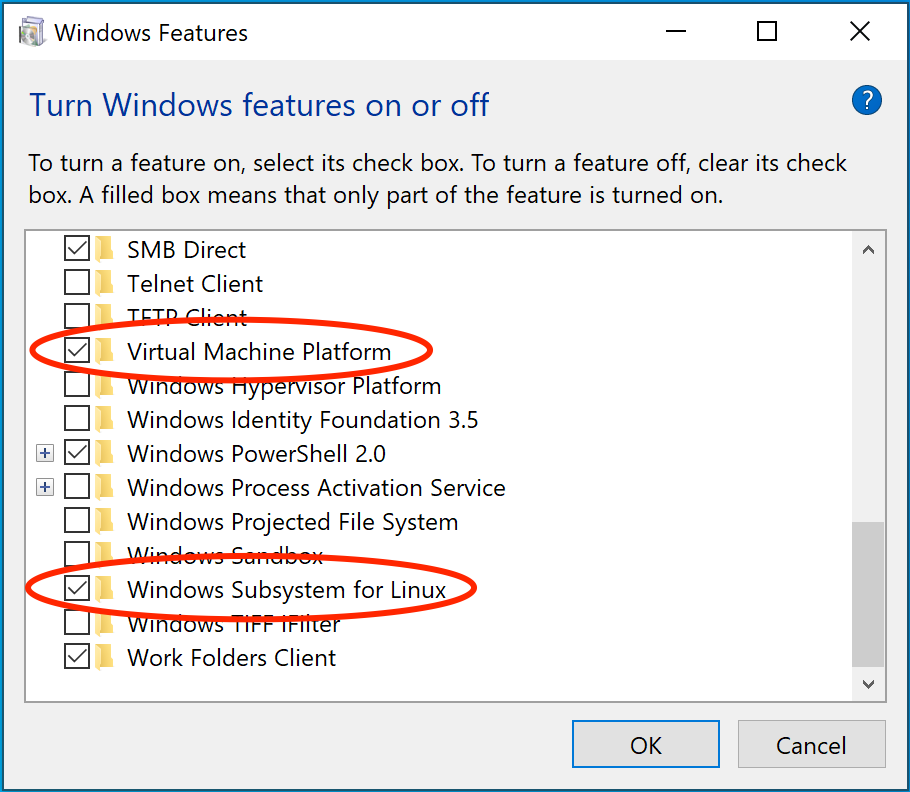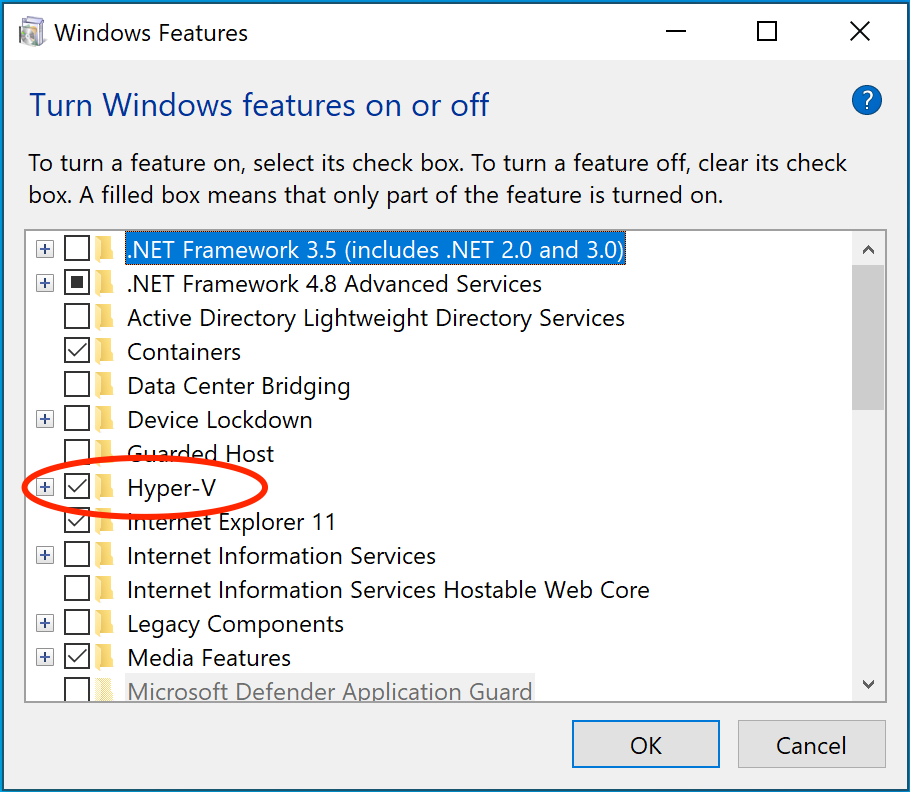Download Docker Desktop
About Docker Desktop for Mac
- The Docker binaries are installed by default in /Applications/Docker.app/Contents/Resources/bin. Docker Desktop creates symlinks for the binaries in /usr/local/bin, which means they're automatically included in PATH on most systems.
- It is your responsibility to ensure that localhost is resolved to 127.0.0.1 and if Kubernetes is used, that kubernetes.docker.internal is resolved to 127.0.0.1.
- With Docker Desktop, the Docker daemon and containers run in a lightweight Linux VM managed by Docker. This means that although containers run by default as root, this doesn't grant root access to the Mac host machine.
About Docker Desktop for Windows
- Docker Desktop for Windows can be backended by either Windows Subsystem for Linux 2 (WSL 2) or Hyper-V. WSL 2 and Hyper-V have their own advantages and disadvantages, depending on your specific set up and your planned use case.
- WSL 2 backend: Turn on the WSL 2 feature on Windows. For detailed instructions, refer to the Microsoft documentation .
- Hyper-V backend: Turn on Hyper-V and Containers Windows features. For detailed instructions, refer to the Microsoft documentation .
-
If your admin account is different to your user account, you must add
the user to the docker-users group:
- Run Computer Management as an administrator.
- Navigate to Local Users and Groups > Groups > docker-users.
- Right-click to add the user to the group.
- Sign out and sign back in for the changes to take effect.
General Troubleshoot
I. Make sure certificates are set up correctly
Docker Desktop ignores certificates listed under insecure registries,
and does not send client certificates to them. Commands like
docker run
that attempt to pull from the registry produces error messages on the
command line, like this:
Error response from daemon: Get http://192.168.203.139:5858/v2/:
malformed HTTP response "\x15\x03\x01\x00\x02\x02"
As well as on the registry. For example:
2017/06/20 18:15:30 http: TLS handshake error from
192.168.203.139:52882: tls: client didn't provide a certificate
2017/06/20 18:15:30 http: TLS handshake error from
192.168.203.139:52883: tls: first record does not look like a TLS
handshake
II. Docker Desktop's UI appears green, distorted, or has visual artifacts
Docker Desktop uses hardware-accelerated graphics by default, which may
cause problems for some GPUs. In such cases, Docker Desktop will launch
successfully, but some screens may appear green, distorted, or have some
visual artifacts.
To work around this issue, disable hardware acceleration by creating a
"disableHardwareAcceleration": true entry in
Docker Desktop's settings.json file. You can find this file at:
Mac:
~/Library/Group Containers/group.com.docker/settings.json
Windows:
C:\Users\[USERNAME]\AppData\Roaming\Docker\settings.json
After updating the settings.json file, close
and restart Docker Desktop to apply the changes.
Troubleshoot for Mac
I. Docker Desktop fails to start on MacOS
On MacOS, Docker Desktop creates Unix domain sockets used for
inter-process communication. Docker fails to start if the absolute path
length of any of these sockets exceeds the OS limitation which is 104
characters on MacOS. If the user ID length is such that the absolute
path of the socket exceeds the OS path length limitation, then Docker
Desktop is unable to create the socket and fails to start. The
workaround for this is to shorten the user ID which we recommend has a
maximum length of 33 characters on MacOS.
Following are the examples of errors on MacOS which indicate that the
startup failure was due to exceeding the above mentioned OS limitation:
[vpnkit-bridge][F] listen unix
<HOME>/Library/Containers/com.docker.docker/Data/http-proxy-control.sock:
bind: invalid argument
[com.docker.backend][E] listen(vsock:4099) failed: listen unix
<HOME>/Library/Containers/com.docker.docker/Data/vms/0/00000002.00001003:
bind: invalid argument
II. Incompatible CPU detected
Docker Desktop requires a processor (CPU) that supports virtualization
and, more specifically, the Apple Hypervisor framework. Docker Desktop
is only compatible with Mac systems that have a CPU that supports the
Hypervisor framework. Most Macs built in 2010 and later support it,as
described in the Apple Hypervisor Framework documentation about
supported hardware:
Generally, machines with an Intel VT-x feature set that includes
Extended Page Tables (EPT) and Unrestricted Mode are supported.
To check if your Mac supports the Hypervisor framework, run the
following command in a terminal window.
sysctl kern.hv_support
If your Mac supports the Hypervisor Framework, the command prints
kern.hv_support: 1.
If not, the command prints kern.hv_support: 0.
III. VPNKit keeps breaking
In Docker Desktop version 4.19, gVisor replaced VPNKit to enhance the
performance of VM networking when using the Virtualization framework on
macOS Ventura and above.
To continue using VPNKit, add
"networkType":"vpnkit" to your
settings.json file located at
~/Library/Group Containers/group.com.docker/settings.json.
Troubleshoot for Windows
I. Permissions errors on data directories for shared volumes
When sharing files from Windows, Docker Desktop sets permissions on
shared volumes to a default value of 0777 (read, write, execute
permissions for user and for
group).
The default permissions on shared volumes are not configurable. If you
are working with applications that require permissions different from
the shared volume defaults at container runtime, you need to either use
non-host-mounted volumes or find a way to make the applications work
with the default file permissions.
II. Volume mounting requires shared folders for Linux containers
If you are using mounted volumes and get runtime errors indicating an
application file is not found, access is denied to a volume mount, or a
service cannot start, such as when using Docker Compose, you might need
to turn on shared folders.
With the Hyper-V backend, mounting files from Windows requires shared
folders for Linux containers. From Settings, select Shared Folders and
share the folder that contains the Dockerfile and volume.
III. Avoid unexpected syntax errors, use Unix style line endings for files in containers
Any file destined to run inside a container must use Unix style
\n line endings. This includes files
referenced at the command line for builds and in RUN commands in Docker
files.
Docker containers and docker build run in a
Unix environment, so files in containers must use Unix style line
endings: \n, not Windows style:
\r\n. Keep this in mind when authoring files
such as shell scripts using Windows tools, where the default is likely
to be Windows style line endings. These commands ultimately get passed
to Unix commands inside a Unix based container (for example, a shell
script passed to /bin/sh). If Windows style
line endings are used, docker run fails with
syntax errors.
IV. Virtualization for WSL 2 and Windows Home
Enable the following features:
- Virtual Machine Platform
- Windows Subsystem for Linux
- Virtualization enabled in the BIOS
- Hypervisor enabled at Windows startup

V. Virtualization for Hyper-V
On Windows 10 Pro or Enterprise, you can also use Hyper-V with the
following features enabled:
- Hyper-V installed and working
- Virtualization enabled in the BIOS
- Hypervisor enabled at Windows startup

Docker Desktop requires Hyper-V as well as the Hyper-V Module for
Windows PowerShell to be installed and enabled. The Docker Desktop
installer enables it for you.
Docker Desktop also needs two CPU hardware features to use Hyper-V:
Virtualization and Second Level Address Translation (SLAT), which is
also called Rapid Virtualization Indexing (RVI). On some systems,
Virtualization must be enabled in the BIOS. The steps required are
vendor-specific, but typically the BIOS option is called
Virtualization Technology (VTx) or something
similar. Run the command systeminfo to check
all required Hyper-V features.
VI. Turn on Virtualization
In addition to Hyper-V or WSL 2, virtualization must be turned on. Check
the Performance tab on the Task Manager. Alternatively, you can type
'systeminfo' into your terminal. If you see
'Hyper-V Requirements: A hypervisor has been detected. Features
required for Hyper-V will not be displayed', then virtualization is enabled.
If you manually uninstall Hyper-V, WSL 2 or turn off virtualization,
Docker Desktop cannot start.
VII. Hypervisor enabled at Windows startup
If you have completed the steps described above and are still
experiencing Docker Desktop startup issues, this could be because the
Hypervisor is installed, but not launched during Windows startup. Some
tools (such as older versions of Virtual Box) and video game installers
turn off hypervisor on boot. To turn it back on:
- Open an administrative console prompt.
- Run bcdedit /set hypervisorlaunchtype auto.
- Restart Windows.
VIII. Docker Desktop Access Denied error message when starting Docker Desktop
Docker Desktop displays the
Docker Desktop - Access Denied error if a
Windows user is not part of the
docker-users group.
If your admin account is different to your user account, add the
docker-users group. Run Computer Management as
an administrator and navigate to
Local Users and Groups > Groups > docker-users.
Right-click to add the user to the group. Sign out and sign back in for
the changes to take effect.